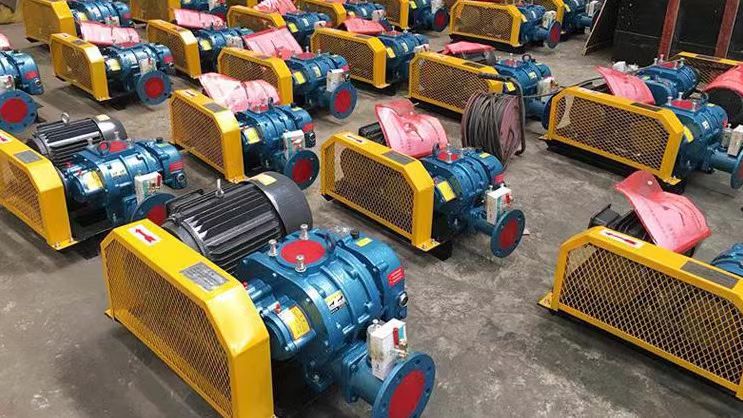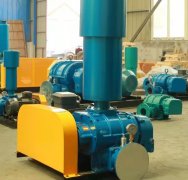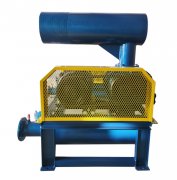In aquaculture, Roots blowers are mainly used for oxygenation and aeration (such as fish ponds, shrimp ponds, sea cucumber circles, etc.), and their selection directly affects the aquaculture density and dissolved oxygen efficiency. The following is a guide for selecting Roots blowers for aquaculture, covering key parameters, calculation methods, and precautions.
---

**1、 Core parameters for selecting Roots blowers for aquaculture**
|* * Parameter * * | * * Unit * * | * * Recommended Range/Formula * * | * * Explanation * *|
|------------------|----------|----------------------------------|-------------------------------------------------------------------------|
|Air volume (flow rate) * * | m3/min | * * 0.5~20 m3/min * * (calculated based on the water body) | It needs to meet the dissolved oxygen demand of the water body (generally 1.5~3.0mg/L)|
|Pressure * * | kPa (bar) | * * 9.8~49 kPa (0.1~0.5 bar) * * | Water depth 1m ≈ 9.8kPa, requiring coverage of aeration pipeline resistance+margin|
|* * Power * | kW | * * 0.75~22 kW * * | Power=air volume x pressure/efficiency (aquaculture usually chooses low-power energy-saving models)|
|Aeration depth * * | m | * * 1.5~4.0 m * * | The deeper the water depth, the higher the required pressure (for every additional 1m, the pressure increases by 9.8kPa)|
|* * Aeration method * * | - | Micro porous aeration/nanotube/jet aeration | Micro porous aeration has high efficiency (dissolved oxygen utilization rate>30), but requires higher air pressure|
|* * Noise Requirements * * | dB (A) | * *<75 dB (A) * * | The breeding farm requires low noise and can choose to use a silent type or install a muffler|
|* * Protection level * * | - | IP55 or above | Aquatic environment is humid and needs to be moisture-proof and corrosion-resistant|
---
**2、 Selection steps**
**1. Calculate the required air volume (Q)**
The air demand for aquaculture mainly depends on the volume of the water body and the target dissolved oxygen level.
**Formula * *:
\[
Q = \frac{V \times ΔO_2 \times K}{24 \times 60 \times E}
\]
-(V): Water volume (m3)
-Δ O2: Target dissolved oxygen increment (mg/L, usually 1.5~3.0)
-(K): Coefficient (1.2~1.5)
-(E): Oxygen utilization rate of aeration equipment (microporous aeration ≈ 30, ordinary aeration ≈ 15)
**Example * *:
-Fish pond volume * * 1000m3 * *, target dissolved oxygen increment * * 2mg/L * *, microporous aeration (E=30).
- \(Q = \frac{1000 \times 2 \times 1.3}{24 \times 60 \times 0.3} ≈ 6.0 \, \text{m3/min}\)
**Select air volume * *:** 6-8 m3/min * * (with reserved margin).
---
**2. Determine the required pressure (P)**
The pressure needs to meet the requirements of * * aeration depth+pipeline resistance * *:
\[
P=9.8 \ times H+Δ P \ quad (\ text {unit: kPa})
\]
-(H): Immersion depth of aeration head (m)
-Δ P: Pipeline pressure loss (usually taken as 5-10kPa)
**Example * *:
-Depth of aeration head * * 2.5m * *, pipeline pressure loss * * 8kPa * *.
- \(P = 9.8 \times 2.5 + 8 ≈ 32.5 \, \text{kPa}\)
**Selection pressure * *:** 39.2 kPa (0.4 bar) * * (rounded up).
---
**3. Select motor power**
Calculate power based on air volume and pressure:
\[
P_ {\ text {motor}}=\ frac {Q \ times P} {60 \ times \ eta} \ quad (\ text {unit: kW})
\]
-(eta): Fan efficiency (Roots blower generally 0.6~0.8)
**Example * *:
-(Q=8, \ text {m3/min} \), \ (P=39.2, \ text {kPa} \), \ (\ eta=0.7 \).
-(P_ {\ text {motor}}=\ frac {8 \ times 39.2} {60 \ times 0.7} ≈ 7.5 \, \ text {kW} \)
**Selection power * *:** 7.5 kW * * (optional * * 7.5 kW or 11 kW * * to meet peak demand).
---
**3、 Recommended configuration for aquaculture fans**
|* * Aquaculture scale * * | * * Water volume (m3) * * | * * Recommended air volume (m3/min) * * | * * Recommended power (kW) * * | * * Pressure (kPa) * *|
|--------------------|-------------------|-----------------------|-------------------|-----------------|
|Small fish pond/nursery pond | 100~500 | 0.5~3.0 | 0.75~3.0 | 19.6~29.4|
|Medium scale breeding pond | 500~2000 | 3.0~10.0 | 3.0~11 | 29.4~39.2|
|Large fish pond/shrimp pond | 2000~5000 | 10.0~20.0 | 11~22 | 39.2~49.0|
---
**4、 Selection precautions**
1. * * Aeration equipment matching**
-Micro porous aeration requires higher pressure (≥ 39.2kPa), while nanotube aeration can reduce air flow requirements.
-Avoid clogging of the aeration head (regular cleaning, pre filter).
2. Energy saving and durability**
-Preferred choice is a three blade Roots blower with low noise and high efficiency.
-Variable frequency control can adjust the air volume to adapt to changes in dissolved oxygen during day and night.
3. * * Environmental adaptability**
-Select * * stainless steel material * * for coastal areas (anti salt spray corrosion).
-A damp environment requires a protection level of IP55 or above.
4. * * Maintenance points**
-Check the gear oil and bearing lubrication every 3 months.
-Regularly clean the intake filter to prevent dust from entering the impeller.
---
**5、 Frequently Asked Questions and Answers**
**Q1: How to determine if the fan is sufficient**
-Detect dissolved oxygen in water (DO meter), and the dissolved oxygen at night should be ≥ 4mg/L.
-Observe whether the fish are floating (signs of hypoxia).
**Q2: Can one machine share multiple pools**
-Sure, but it is necessary to calculate the total air demand and ensure that the pipeline pressure is balanced.
**Q3: How to choose between variable frequency and fixed frequency**
-* * Variable frequency * *: Suitable for scenarios with large fluctuations in dissolved oxygen demand (such as high-density farming), saving 20-30% energy.
-Fixed frequency: Low cost, suitable for stable working conditions.
---
By selecting according to the above method, it is possible to ensure that the Paultz fan can provide stable oxygenation support for aquaculture. Suggest consulting the manufacturer to provide working condition data for a more accurate configuration plan.



